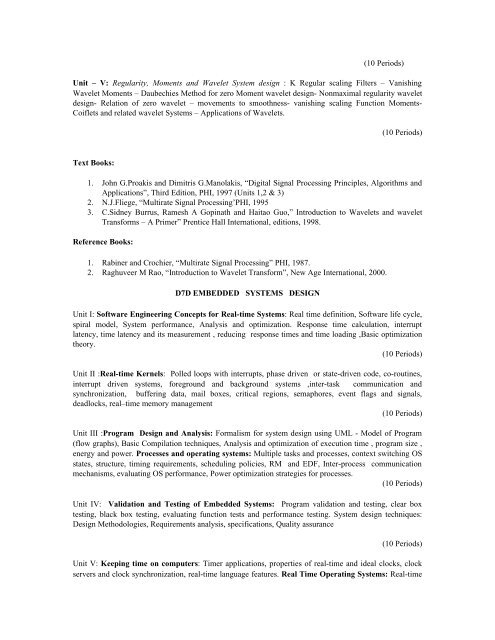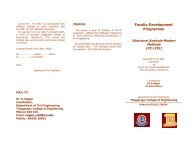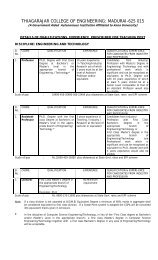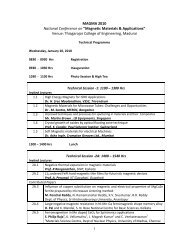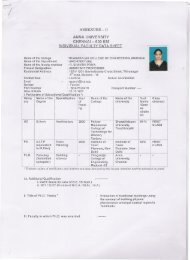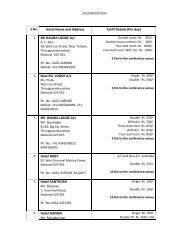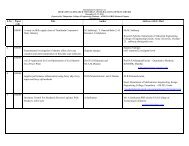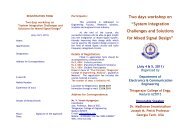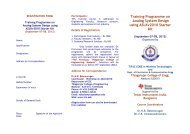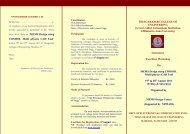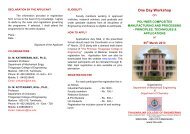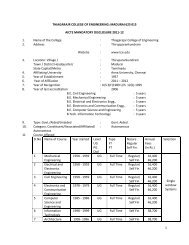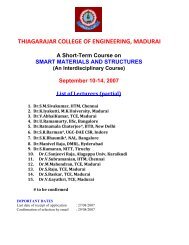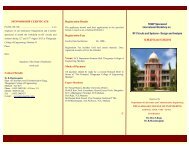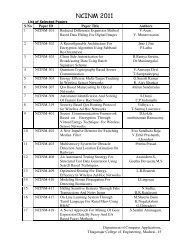THIAGARAJAR COLLEGE OF ENGINEERING: MADURAI – 625 015 ...
THIAGARAJAR COLLEGE OF ENGINEERING: MADURAI – 625 015 ...
THIAGARAJAR COLLEGE OF ENGINEERING: MADURAI – 625 015 ...
- TAGS
- thiagarajar
- college
- madurai
- tce.edu
Create successful ePaper yourself
Turn your PDF publications into a flip-book with our unique Google optimized e-Paper software.
(10 Periods)<br />
Unit <strong>–</strong> V: Regularity, Moments and Wavelet System design : K Regular scaling Filters <strong>–</strong> Vanishing<br />
Wavelet Moments <strong>–</strong> Daubechies Method for zero Moment wavelet design- Nonmaximal regularity wavelet<br />
design- Relation of zero wavelet <strong>–</strong> movements to smoothness- vanishing scaling Function Moments-<br />
Coiflets and related wavelet Systems <strong>–</strong> Applications of Wavelets.<br />
Text Books:<br />
(10 Periods)<br />
1. John G.Proakis and Dimitris G.Manolakis, “Digital Signal Processing Principles, Algorithms and<br />
Applications”, Third Edition, PHI, 1997 (Units 1,2 & 3)<br />
2. N.J.Fliege, “Multirate Signal Processing’PHI, 1995<br />
3. C.Sidney Burrus, Ramesh A Gopinath and Haitao Guo,” Introduction to Wavelets and wavelet<br />
Transforms <strong>–</strong> A Primer” Prentice Hall International, editions, 1998.<br />
Reference Books:<br />
1. Rabiner and Crochier, “Multirate Signal Processing” PHI, 1987.<br />
2. Raghuveer M Rao, “Introduction to Wavelet Transform”, New Age International, 2000.<br />
D7D EMBEDDED SYSTEMS DESIGN<br />
Unit I: Software Engineering Concepts for Real-time Systems: Real time definition, Software life cycle,<br />
spiral model, System performance, Analysis and optimization. Response time calculation, interrupt<br />
latency, time latency and its measurement , reducing response times and time loading ,Basic optimization<br />
theory.<br />
(10 Periods)<br />
Unit II :Real-time Kernels: Polled loops with interrupts, phase driven or state-driven code, co-routines,<br />
interrupt driven systems, foreground and background systems ,inter-task communication and<br />
synchronization, buffering data, mail boxes, critical regions, semaphores, event flags and signals,<br />
deadlocks, real<strong>–</strong>time memory management<br />
(10 Periods)<br />
Unit III :Program Design and Analysis: Formalism for system design using UML - Model of Program<br />
(flow graphs), Basic Compilation techniques, Analysis and optimization of execution time , program size ,<br />
energy and power. Processes and operating systems: Multiple tasks and processes, context switching OS<br />
states, structure, timing requirements, scheduling policies, RM and EDF, Inter-process communication<br />
mechanisms, evaluating OS performance, Power optimization strategies for processes.<br />
(10 Periods)<br />
Unit IV: Validation and Testing of Embedded Systems: Program validation and testing, clear box<br />
testing, black box testing, evaluating function tests and performance testing. System design techniques:<br />
Design Methodologies, Requirements analysis, specifications, Quality assurance<br />
(10 Periods)<br />
Unit V: Keeping time on computers: Timer applications, properties of real-time and ideal clocks, clock<br />
servers and clock synchronization, real-time language features. Real Time Operating Systems: Real-time


